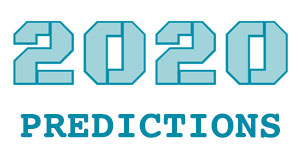It’s been another interesting year in the food and beverage industry as consumer demands continue to shift and push newer and greater innovative products. Based on what we at NPD Group have observed in our ongoing tracking of food and beverage consumption habits, we predict tailwinds behind the following consumer behaviors.
Plant-Based Continues to Sprout
Plant-based food and beverage alternatives have been around for some time but Beyond Meat and Impossible Foods helped propel the plant-based alternative market from fairly niche to mainstream.

Check out our December 2019 issue for more food & beverage predictions!
Since nearly 90% of these consumers also use traditional meat and dairy, it’s fair to say we aren’t becoming vegetarians or vegans; rather consumers are integrating these products as additional options for their daily repertoires.
Will this be a fad or a sustained trend? Clearly time will tell but it seems the flash-in-the-pan time period might have passed as we’ve been using alternatives such as almond milk for decades. As Millennials and Gen Z consumers have grown up with these alternatives from an early age, they come to expect these products to be available when they want them. Plant based dairy items such as cheese could be the next high growth area, in addition to other meat alternatives including chicken.
Food as Medicine
Nearly one-quarter of US adults are currently on a nutrition plan where the goal is to promote long-term health but not necessarily weight loss. This represents a dramatic shift in the way consumers approach food and beverage choices compared to the ‘80s and ‘90s, when they changed behaviors in reaction to a health issue.
Increasingly, consumers see food and beverages as a pathway to better health and this is more pronounced among younger adults. And, when health issues arise, many are turning to natural alternatives for help. One in five adults are managing a health condition with their food and beverage choices, which doesn’t mean they aren’t taking any medication—but many first look at their food and beverage consumption options first as the solution before jumping on medication.
The AM Shift
In the last decade, the number of in-home prepared and consumed breakfasts declined but consumers aren’t skipping this meal more often. There has been an increase in morning snack occasions as well as restaurant meals and these together nearly equal decline in traditional in-home eating. Categories increasing during this time are portable and functional reflecting the needs of speed and health, which drive much of our behaviors in the morning. Look to see sustained growth for categories including breakfast sandwiches; juices with functional benefits such as energy; and categories with protein, such as eggs.
Greater Focus on Sustainability
Sustainability is often a tertiary concern in food and beverage and is expressed differently compared to other industries. That said, marketers still need to have a play in this area as it can be a deciding factor for consumers.
Food and beverage is unique because taste and health needs are satisfied first before others come into play. A product’s packaging could be recyclable and sourced sustainably but that won’t matter if consumers find the taste unpalatable. This explains why animal welfare and sustainability rank low on the reasons for using plant-based foods.
That said, consumers are still interested in how products are produced and want to feel better about supporting brands that use sustainable methods.
